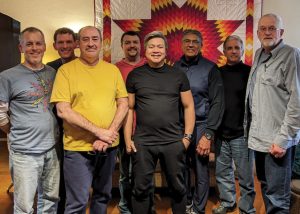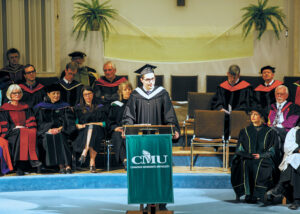In the midst of significant structural change in Mennonite Church Canada, a group of Canadian Mennonite University students came together in December 2015 around the question, “Do young people care about the future of the church?” This initial gathering generated surprising energy among the participants. Soon a group of 15 of us began gathering over a shared meal several times a month to talk about our dreams, hopes and fears for the church. (See “Do young people care about the future of the church?”)
The group, which came to be known as the Emerging Voices Initiative (EVI), consisted of young adults, most of whom could be described as having an itinerant and fugitive relationship with the church. We were raised by various congregations across Canada but had no certainty that we would return to those places. We were passionate about the church but were disoriented by a sense that we were caught between homes, between vocational possibilities and between congregations.
As I got more involved in EVI, I came to recognize that I was not alone in my lack of certainty about my home, my future and my place in the church. I shared this experience with other young adults, and it often created a profound sense of disorientation for us.
In the course of my academic writing at Canadian Mennonite University, I found immense hope for the relationship between young adults and the church through the work of political theorists Sheldon Wolin and Romand Coles. According to them, the itinerant wanderer and the fugitive do not create a crisis for a community; instead, they are the catalysts for envisioning a dialogical community that is rooted in tradition yet open to new and unanticipated possibilities and flexible enough to adapt to them.
I suggest that it is precisely as they live amid the tension of the in-between spaces—between homes, between vocational paths, between churches—that young adults can help the church remember that dwelling in uncertainty and releasing control are critical parts of what it means to be the church. The congregation that can recognize the gift of uncertainty has a profound capacity to meet young adults in these in-between spaces, thereby encouraging them to find a sense of home through remembering, embodying and claiming God’s story as their own.
Choosing our own story?
Young adults are often told that education is the means by which they can choose to be who they want to be and go wherever they desire to go. In the words of ethicist Stanley Hauerwas, young adults are led to “believe they should have no story except the story they choose when they had no story.”
As young adults set out to choose their own story, they face a great deal of pressure to get it right: to pick the right career and to make something of themselves. Often the desire for freedom and the pursuit of the right story lead young adults away from the community and church that raised them. In setting out on their own, they can easily forget that they are already in the middle of a story, the story given to them by the place they came from and the community that raised them, the faith story that formed their framework for understanding the world.
The church also continually faces the temptation to try to control the future, to move in the “right” direction. We witnessed this pressure most recently in the process of restructuring MC Canada, which proposed to shift resources and programs from the national church to the regional churches, and to reorient the church’s focus around the congregation as the primary locus of worship and mission.
The restructuring process expressed the church’s desire to follow God’s Spirit in a time when individualism, relativism and disillusionment with professionalized institutions are culturally pervasive realities. These cultural shifts often seem beyond our control and have therefore created a sense of anxiety for the church as it recognizes that “young adults, and frequently their parents, grandparents, and others, are increasingly disassociating from what they consider to be a staid and possibly irrelevant institution” (Future Directions Task Force, “Interim report”).
In response to this anxiety, the church has focussed on what it believes it can control: the structure of the church. In doing so, however, the church has also demonstrated a tendency to forget that this body is already part of the story of Jesus, a story premised on the radical release of power and control.
Releasing control, tending a habitus
As young adults negotiate their own stories, they desperately need the church to be a social body that resists the temptation to seek control and instead models a countercultural commitment to remembering and embodying the particular relevance of Jesus’ life and practices: love of enemy, nonviolent resistance, repentance, servanthood, dispossession of power.
In the life of the church, such a commitment requires a shift from a politics of “intending” to a politics of “tending,” to borrow Wolin’s terms. According to him, a politics of intending is shaped by the language of contract; this system of power seeks to ensure a future by bringing all of life under a single rational structure and order. In contrast, a politics of tending requires “active care of things close at hand.”
A politics of tending is centred on shared practices, habits and memories that define a place and community in its particularity, and describe how that community will negotiate its future. In this sense, to tend habits is more broadly to tend a habitus, a collective expression of dispositions and tendencies that orient the way we understand, interact with and move through the world.
The Mennonite church, at its best, has an incredible capacity to tend habits of speech, worship and hospitality that mirror the life of Jesus. But these habits can quickly become entrenched. When entrenched habits limit our ability to see more and say more, we begin to reach the edges of the habitus. Habitus, as sociologist and philosopher Pierre Bourdieu conceives it, represents a body of habits that give stability and coherence to a particular narrative. However, this body of habits resists being reopened, reimagined and retold. Coles advocates that we maintain that stability while pushing its edges to generate radical transformation.
“These spaces of possibility,” Coles suggests, “open only when and because gaps, blips and mismatches—failures of articulation—occur.”
It is within these gaps and moments of critical interrogation that truth, imagination, affection and hope begin to be realized and clarified.
Fugitive edges
The task of pushing the edges of the habitus is complicated; disparate places, traditions and practices overlap in ways that make it difficult to know where the edges are. This is where Coles’s metaphor of an ecotone becomes helpful. An ecotone is a meeting ground or an edge between two environments—the place where a forest and a meadow come together, for example. From the Greek oikos (habitation), and tonos (tension), the word ecotone points to a place full of fertile possibilities yet also a place of unpredictability and ambiguity. It is a place where our understandings can be transformed.
Jesus’ good news is that he “interrupts and reorganizes the landscape in ways that are not predictable,” says former Anglican bishop Rowan Williams.
To live into the gospel story, therefore, is to follow Jesus’ example in not becoming competitors for space in this world but rather in competing against the desire to control and determine the right direction or the structure for the church, or the path of one’s life. We are called to carefully and courageously tend the spaces and the edges that we inhabit. Within this call, however, “we cannot know precisely where the edges are, because they are part of what and how we are called into being, and they run throughout our lives and works in ways that precede us and are multidimensional,” say Hauerwas and Coles.
This sense of not knowing where the edges are begins to push toward an account of the church that is not self-contained but instead is defined by its fugitive character.
Mennonite theologian Peter Dula develops the notion of “fugitive ecclesia,” gesturing toward a church body that is episodic and rare. While the life of the church has continuity with the body of Christ, it is predominantly characterized by a patient struggle to work through, and become attentive to, the tensions, struggles and conflicts that emerge in the pursuit of living truthfully.
Rooting, storytelling and wandering
To the extent that they are living fugitive lives, young adults are in a position to help the church understand what it means to be fugitive. At its best, EVI did exactly this. In the winter of 2016, seven EVI members became itinerants, travelling across Canada to lead listening workshops at which churches were invited to add to the “imaginative critical interrogation” (Coles’s phrase) of what it means to be the church.
At the end of the tour, we observed that it had “led to a rich journey of sharing and collecting stories across the country. To find our way forward, we need to tell stories. Stories are how we share meaning, how we name where God is at work in our lives and invite others to do the same. We hope to keep storytelling central as we consider a re-structured church” (EVI “Tour reflection: The church’s future”). (See “EVI listening tour roundup” and “Hearing each other.”)
In each church we visited, the stories we heard reflected the way each community was working to tend the history, memories, and unfolding particularities of that place. While these stories were diverse, they also contained common threads that transcended territorial designations.
Increasingly, I began to understand that the role of EVI was to navigate the in-between spaces and to work to weave the particular stories of local congregations into the Anabaptist story and God’s story more broadly. In building bridges between localities, our task is not so much to ensure that the church gets the structure right as it is to ensure that congregations are not isolated from each other. As young adults wander, question and struggle with the tension of being in between, they need the church to offer a broader story that gives coherence to their travels. This story, while rooted in the memory and wisdom of Jesus, must continue to be receptive to unexpected openings that invite new routes for exploration.
My hope is that in the interplay between storied traditions and fugitive moments, the church will be humble enough to receive the gift of uncertainty from voices speaking from the edges. I hope young adults will find a sense of home in the story of the church as the church struggles with the tensions of living truthfully in a world characterized by competing cultural narratives.
Anika Reynar wrote her undergraduate thesis, “Movement and memory: Storied pedagogy in the age of empire,” in 2017 while a student at Canadian Mennonite University. She is a member of Hope Mennonite Church, Winnipeg. Adapted, by permission of the publisher, from Anika Reynar, “Tending the in-between spaces: Becoming itinerant storytellers,” Vision: A Journal for Church and Theology, Vol. 19, No. 1 (Spring 2018), pages 40-46. All rights reserved.
For discussion
1. How do people in your circles feel pressured to “get it right” and control the future? In what ways do you feel that pressure? What is your response to those expectations?
2. On page 4, Anika Reynar says, “. . . dwelling in uncertainty and releasing control are critical parts of what it means to be church.” Do you agree? Why or why not? What are some ways in which your congregation is a “wanderer and a fugitive”?
3. Think of some in-between spaces in your own reality—what voices are speaking wisdom “from the edges”? How might the church pay better attention to the people who live in those realities? What lessons might those voices have to teach you?
4. On page 5, Reynar calls on the church to “model a countercultural commitment to remember and embody Jesus’ life and practices.” How is your Christian community modelling this commitment? In what ways could your community better embody a countercultural life?
5. What habits does the Mennonite church have that keep us entrenched and limit our vision? Name one practical thing your congregation could do to open new “spaces of possibility” for transformation.
—By Virginia A. Hostetler







Leave a Reply
You must be logged in to post a comment.